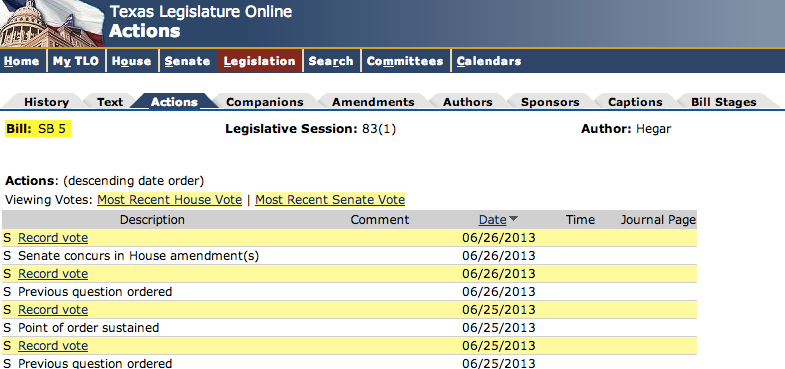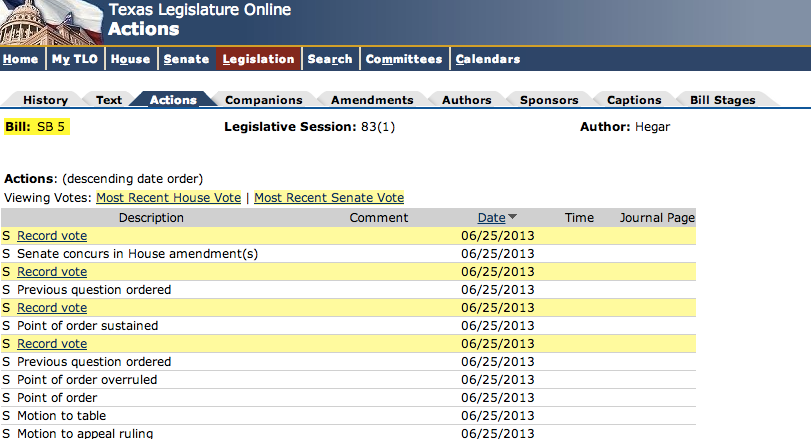26 June 2013
In the early days of 1973, the Supreme Court of the United States published it’s opinion that abortion is a fundamental right under the United States Constitution, thereby subjecting all laws attempting to restrict it to the standard of strict scrutiny, which is defined as ‘the most stringent standard of judicial review used by United States courts. It is part of the hierarchy of standards that courts use to weigh the government’s interest against a constitutional right or principle.’ The Court supported this decision with its interpretation that the Fourteenth Amendment gives the “right of privacy, whether it be founded in the Fourteenth Amendment’s concept of personal liberty and restrictions upon state action, as we feel it is, or, as the district court determined, in the Ninth Amendment’s reservation of rights to the people, is broad enough to encompass a woman’s decision whether or not to terminate her pregnancy.”
What supporters of a woman’s right to choose know is that there will always be situations in which a woman will, for reasons of her own, terminate a pregnancy. The issue, then, becomes not whether a woman will terminate a pregnancy, but whether the laws of the land will respect and support her by allowing for that action to be accomplished safely, with the help of her doctor, instead of in a back alley abortion.
Since the beginning of this discussion, many people who are personally against abortion have supported a woman’s right to choose. During the four decades since Roe v Wade, there has been a steady stream of efforts, mostly by people aligned with religious doctrine of one type or another, to reverse or undermine this SCOTUS decision.
Yesterday was one of those days.
In an effort to use what may be his last term in office, Texas Governor Rick Perry called a special session in an attempt to further restrict the rights of Texas women. The effort to pass Senate Bill 5, aka SB5, went into the wee hours, as Texas State Senator Wendy Davis, with absolute and sometimes hilarious support from the other Senate members of the Texas Democratic Party, stood in opposition to the bill for thirteen hours of non-stop delivery of information, which included reading miles of comments from her constituents, which we got to hear via livestream supplied by The Texas Tribune’s YouTube page, where many clips of last night’s session can be found. An animated overview has been comicalized by NMAtv
The bill :::
By: Hegar, et al. S.B. No. 5
A BILL TO BE ENTITLED
AN ACT
relating to the regulation of abortion procedures, providers, and
facilities; providing penalties.
BE IT ENACTED BY THE LEGISLATURE OF THE STATE OF TEXAS:
SECTION 1. Subchapter A, Chapter 171, Health and Safety
Code, is amended by adding Section 171.0031 to read as follows:
Sec. 171.0031. REQUIREMENTS OF PHYSICIAN; OFFENSE. (a) A
physician performing or inducing an abortion:
(1) must, on the date the abortion is performed, have
active admitting privileges at a hospital that:
(A) is located not further than 30 miles from the
location at which the abortion is performed or induced; and
(B) provides obstetrical or gynecological health
care services; and
(2) shall provide the pregnant woman with:
(A) a telephone number by which the pregnant
woman may reach the physician, or other health care personnel
employed by the physician or by the facility at which the abortion
was performed with access to the woman’s relevant medical records,
24 hours a day to request assistance for any complications that
arise from the performance of the abortion or ask health-related
questions regarding the abortion; and
(B) the name and telephone number of the nearest
hospital to the home of the pregnant woman at which an emergency
arising from the abortion would be treated.
(b) A physician who violates Subsection (a) commits an
offense. An offense under this section is a Class A misdemeanor
punishable by a fine only, not to exceed $4,000.
SECTION 2. Chapter 171, Health and Safety Code, is amended
by adding Subchapter C to read as follows:
SUBCHAPTER C. ABORTION-INDUCING DRUGS
Sec. 171.041. DEFINITIONS. In this subchapter:
(1) “Abortion-inducing drug” means a drug, a medicine,
or any other substance, including a regimen of two or more drugs,
medicines, or substances, prescribed, dispensed, or administered
with the intent of terminating a clinically diagnosable pregnancy
of a woman and with knowledge that the termination will, with
reasonable likelihood, cause the death of the woman’s unborn child.
The term includes off-label use of drugs, medicines, or other
substances known to have abortion-inducing properties that are
prescribed, dispensed, or administered with the intent of causing
an abortion, including the Mifeprex regimen. The term does not
include a drug, medicine, or other substance that may be known to
cause an abortion but is prescribed, dispensed, or administered for
other medical reasons.
(2) “Final printed label” or “FPL” means the
informational document approved by the United States Food and Drug
Administration for an abortion-inducing drug that:
(A) outlines the protocol authorized by that
agency and agreed to by the drug company applying for authorization
of the drug by that agency; and
(B) delineates how a drug is to be used according
to approval by that agency.
(3) “Gestational age” means the amount of time that
has elapsed since the first day of a woman’s last menstrual period.
(4) “Medical abortion” means the administration or use
of an abortion-inducing drug to induce an abortion.
(5) “Mifeprex regimen,” “RU-486 regimen,” or “RU-486”
means the abortion-inducing drug regimen approved by the United
States Food and Drug Administration that consists of administering
mifepristone and misoprostal.
(6) “Physician” means an individual who is licensed to
practice medicine in this state, including a medical doctor and a
doctor of osteopathic medicine.
(7) “Pregnant” means the female reproductive
condition of having an unborn child in a woman’s uterus.
(8) “Unborn child” means an offspring of human beings
from conception until birth.
Sec. 171.0411. APPLICABILITY TO MEDICAL ABORTION. This
subchapter does not apply to an abortion with the intent to:
(1) save the life or preserve the health of an unborn
child;
(2) remove a dead, unborn child whose death was caused
by spontaneous abortion;
(3) remove an ectopic pregnancy; or
(4) treat a maternal disease or illness for which a
prescribed drug, medicine, or other substance is indicated.
Sec. 171.042. ENFORCEMENT BY TEXAS MEDICAL BOARD.
Notwithstanding Section 171.005, the Texas Medical Board shall
enforce this subchapter.
Sec. 171.043. DISTRIBUTION OF ABORTION-INDUCING DRUG.
(a) A person may not knowingly give, sell, dispense, administer,
provide, or prescribe an abortion-inducing drug to a pregnant woman
for the purpose of inducing an abortion in the pregnant woman or
enabling another person to induce an abortion in the pregnant woman
unless:
(1) the person who gives, sells, dispenses,
administers, provides, or prescribes the abortion-inducing drug is
a physician;
(2) the physician administering the abortion-inducing
drug administers the drug to the woman while both are present at an
abortion facility licensed under Chapter 245; and
(3) the provision, prescription, or administration of
the abortion-inducing drug, except as provided by Subsection (a-1),
satisfies the protocol tested and authorized by the United States
Food and Drug Administration as outlined in the final printed label
of the abortion-inducing drug.
(a-1) A person may provide, prescribe, or administer the
abortion-inducing drug in the dosage amount prescribed by the
clinical management guidelines defined by the American Congress of
Obstetricians and Gynecologists Practice Bulletin as those
guidelines existed on January 1, 2013.
(b) Before the physician gives, sells, dispenses,
administers, provides, or prescribes an abortion-inducing drug,
the physician must examine the pregnant woman and document, in the
woman’s medical record, the gestational age and intrauterine
location of the pregnancy.
(c) The physician who gives, sells, dispenses, administers,
provides, or prescribes an abortion-inducing drug shall provide the
pregnant woman with:
(1) a copy of the final printed label of that
abortion-inducing drug; and
(2) a telephone number by which the pregnant woman may
reach the physician, or other health care personnel employed by the
physician or by the facility at which the abortion was performed
with access to the woman’s relevant medical records, 24 hours a day
to request assistance for any complications that arise from the
administration or use of the drug or ask health-related questions
regarding the administration or use of the drug.
(d) The physician who gives, sells, dispenses, administers,
provides, or prescribes the abortion-inducing drug, or the
physician’s agent, must schedule a follow-up visit for the woman to
occur not more than 14 days after the administration or use of the
drug. At the follow-up visit, the physician must:
(1) confirm that the pregnancy is completely
terminated; and
(2) assess the degree of bleeding.
(e) The physician who gives, sells, dispenses, administers,
provides, or prescribes the abortion-inducing drug, or the
physician’s agent, shall make a reasonable effort to ensure that
the woman returns for the scheduled follow-up visit under
Subsection (d). The physician or the physician’s agent shall
document a brief description of any effort made to comply with this
subsection, including the date, time, and name of the person making
the effort, in the woman’s medical record.
(f) If a physician gives, sells, dispenses, administers,
provides, or prescribes an abortion-inducing drug to a pregnant
woman for the purpose of inducing an abortion as authorized by this
section and the physician knows that the woman experiences a
serious adverse event, as defined by the MedWatch Reporting System,
during or after the administration or use of the drug, the physician
shall report the event to the United States Food and Drug
Administration through the MedWatch Reporting System not later than
the third day after the date the physician learns that the event
occurred.
Sec. 171.044. ADMINISTRATIVE PENALTY. (a) The Texas
Medical Board may take disciplinary action under Chapter 164,
Occupations Code, or assess an administrative penalty under
Subchapter A, Chapter 165, Occupations Code, against a person who
violates Section 171.043.
(b) A penalty may not be assessed under this section against
a pregnant woman who receives a medical abortion.
SECTION 3. Subsection (a), Section 245.010, Health and
Safety Code, is amended to read as follows:
(a) The rules must contain minimum standards to protect the
health and safety of a patient of an abortion facility and must
contain provisions requiring compliance with the requirements of
Subchapter B, Chapter 171. On and after September 1, 2014, the
minimum standards for an abortion facility must be equivalent to
the minimum standards adopted under Section 243.010 for ambulatory
surgical centers.
SECTION 4. Effective September 1, 2014, Subsection (c),
Section 245.010, Health and Safety Code, is repealed.
SECTION 5. This Act may not be construed to repeal, by
implication or otherwise, Subdivision (18), Subsection (a),
Section 164.052, Occupations Code, Section 170.002, Health and
Safety Code, or any other provision of Texas law regulating or
restricting abortion not specifically addressed by this Act. An
abortion that complies with this Act but violates any other law is
unlawful. An abortion that complies with another state law but
violates this Act is unlawful as provided in this Act.
SECTION 6. (a) If some or all of the provisions of this Act
are ever temporarily or permanently restrained or enjoined by
judicial order, all other provisions of Texas law regulating or
restricting abortion shall be enforced as though the restrained or
enjoined provisions had not been adopted; provided, however, that
whenever the temporary or permanent restraining order or injunction
is stayed or dissolved, or otherwise ceases to have effect, the
provisions shall have full force and effect.
(b) Mindful of Leavitt v. Jane L., 518 U.S. 137 (1996), in
which in the context of determining the severability of a state
statute regulating abortion the United States Supreme Court held
that an explicit statement of legislative intent is controlling, it
is the intent of the legislature that every provision, section,
subsection, sentence, clause, phrase, or word in this Act, and
every application of the provisions in this Act, are severable from
each other. If any application of any provision in this Act to any
person, group of persons, or circumstances is found by a court to be
invalid, the remaining applications of that provision to all other
persons and circumstances shall be severed and may not be affected.
All constitutionally valid applications of this Act shall be
severed from any applications that a court finds to be invalid,
leaving the valid applications in force, because it is the
legislature’s intent and priority that the valid applications be
allowed to stand alone. Even if a reviewing court finds a provision
of this Act to impose an undue burden in a large or substantial
fraction of relevant cases, the applications that do not present an
undue burden shall be severed from the remaining provisions and
shall remain in force, and shall be treated as if the legislature
had enacted a statute limited to the persons, group of persons, or
circumstances for which the statute’s application does not present
an undue burden. The legislature further declares that it would
have passed this Act, and each provision, section, subsection,
sentence, clause, phrase, or word, and all constitutional
applications of this Act, irrespective of the fact that any
provision, section, subsection, sentence, clause, phrase, or word,
or applications of this Act, were to be declared unconstitutional
or to represent an undue burden.
(c) If any provision of this Act is found by any court to be
unconstitutionally vague, then the applications of that provision
that do not present constitutional vagueness problems shall be
severed and remain in force.
SECTION 7. (a) The executive commissioner of the Health
and Human Services Commission shall adopt the standards required by
Section 245.010, Health and Safety Code, as amended by this Act, not
later than January 1, 2014.
(b) A facility licensed under Chapter 245, Health and Safety
Code, is not required to comply with the standards adopted under
Section 245.010, Health and Safety Code, as amended by this Act,
before September 1, 2014.
SECTION 8. This Act takes effect immediately if it receives
a vote of two-thirds of all the members elected to each house, as
provided by Section 39, Article III, Texas Constitution. If this
Act does not receive the vote necessary for immediate effect, this
Act takes effect on the 91st day after the last day of the
legislative session.
The Texas Senate developed session rules for allowing and interrupting a filibuster, which Senator Davis followed throughout her thirteen hours of protest against this new attempt by the GOP to usurp the rights of Texas women. Davis was stripped of the first of three allowable strikes toward losing the right to continue after being accused of making comments which were not germane to the discussion. Hours later, she was robbed of her second strike.
Ms. Davis has a disability, and was charged with her second strike for accepting help from a colleague in her effort to put on her back brace. After standing for so many hours, she was penalized for addressing her health needs, likely in violation of the protections provided by Section 12112 of the Americans With Disability Act.
By all accounts (and by design) Senate Bill 5, combined with recently passed legislation requiring a woman to submit to mandatory ultrasound before undergoing the process of abortion, is a direct assault on and will undermine women’s rights to self-determination, to privacy, and to health care.
The sonogram bill :::
H.B. No. 15
AN ACT
relating to informed consent to an abortion.
BE IT ENACTED BY THE LEGISLATURE OF THE STATE OF TEXAS:
SECTION 1. Section 171.002, Health and Safety Code, is
amended to read as follows:
Sec. 171.002. DEFINITIONS [DEFINITION]. In this chapter:
(1) “Abortion” [, “abortion”] means the use of any
means to terminate the pregnancy of a female known by the attending
physician to be pregnant with the intention that the termination of
the pregnancy by those means will, with reasonable likelihood,
cause the death of the fetus.
(2) “Abortion provider” means a facility where an
abortion is performed, including the office of a physician and a
facility licensed under Chapter 245.
(3) “Medical emergency” means a life-threatening
physical condition aggravated by, caused by, or arising from a
pregnancy that, as certified by a physician, places the woman in
danger of death or a serious risk of substantial impairment of a
major bodily function unless an abortion is performed.
(4) “Sonogram” means the use of ultrasonic waves for
diagnostic or therapeutic purposes, specifically to monitor an
unborn child.
SECTION 2. Section 171.012, Health and Safety Code, is
amended by amending Subsections (a), (b), and (c) and adding
Subsection (a-1) to read as follows:
(a) Consent [Except in the case of a medical emergency,
consent] to an abortion is voluntary and informed only if:
(1) the physician who is to perform the abortion [or
the referring physician] informs the pregnant woman on whom the
abortion is to be performed of:
(A) the physician’s name [of the physician who
will perform the abortion];
(B) the particular medical risks associated with
the particular abortion procedure to be employed, including, when
medically accurate:
(i) the risks of infection and hemorrhage;
(ii) the potential danger to a subsequent
pregnancy and of infertility; and
(iii) the possibility of increased risk of
breast cancer following an induced abortion and the natural
protective effect of a completed pregnancy in avoiding breast
cancer;
(C) the probable gestational age of the unborn
child at the time the abortion is to be performed; and
(D) the medical risks associated with carrying
the child to term;
(2) the physician who is to perform the abortion or the
physician’s agent informs the pregnant woman that:
(A) medical assistance benefits may be available
for prenatal care, childbirth, and neonatal care;
(B) the father is liable for assistance in the
support of the child without regard to whether the father has
offered to pay for the abortion; and
(C) public and private agencies provide
pregnancy prevention counseling and medical referrals for
obtaining pregnancy prevention medications or devices, including
emergency contraception for victims of rape or incest; [and]
(3) the physician who is to perform the abortion or the
physician’s agent:
(A) provides [(D)] the pregnant woman with [has
the right to review] the printed materials described by Section
171.014; and
(B) informs the pregnant woman[,] that those
materials:
(i) have been provided by the [Texas]
Department of State Health Services;
(ii) [and] are accessible on an Internet
website sponsored by the department;
(iii) [, and that the materials] describe
the unborn child and list agencies that offer alternatives to
abortion; and
(iv) include a list of agencies that offer
sonogram services at no cost to the pregnant woman;
(4) before any sedative or anesthesia is administered
to the pregnant woman and at least 24 hours before the abortion or
at least two hours before the abortion if the pregnant woman waives
this requirement by certifying that she currently lives 100 miles
or more from the nearest abortion provider that is a facility
licensed under Chapter 245 or a facility that performs more than 50
abortions in any 12-month period:
(A) the physician who is to perform the abortion
or an agent of the physician who is also a sonographer certified by
a national registry of medical sonographers performs a sonogram on
the pregnant woman on whom the abortion is to be performed;
(B) the physician who is to perform the abortion
displays the sonogram images in a quality consistent with current
medical practice in a manner that the pregnant woman may view them;
(C) the physician who is to perform the abortion
provides, in a manner understandable to a layperson, a verbal
explanation of the results of the sonogram images, including a
medical description of the dimensions of the embryo or fetus, the
presence of cardiac activity, and the presence of external members
and internal organs; and
(D) the physician who is to perform the abortion
or an agent of the physician who is also a sonographer certified by
a national registry of medical sonographers makes audible the heart
auscultation for the pregnant woman to hear, if present, in a
quality consistent with current medical practice and provides, in a
manner understandable to a layperson, a simultaneous verbal
explanation of the heart auscultation;
(5) before receiving a sonogram under Subdivision
(4)(A) and [(3) the woman certifies in writing] before the abortion
is performed and before any sedative or anesthesia is administered,
the pregnant woman completes and certifies with her signature an
election form that states as follows:
“ABORTION AND SONOGRAM ELECTION
(1) THE INFORMATION AND PRINTED MATERIALS
DESCRIBED BY SECTIONS 171.012(a)(1)-(3), TEXAS HEALTH
AND SAFETY CODE, HAVE BEEN PROVIDED AND EXPLAINED TO
ME.
(2) I UNDERSTAND THE NATURE AND CONSEQUENCES OF
AN ABORTION.
(3) TEXAS LAW REQUIRES THAT I RECEIVE A SONOGRAM
PRIOR TO RECEIVING AN ABORTION.
(4) I UNDERSTAND THAT I HAVE THE OPTION TO VIEW
THE SONOGRAM IMAGES.
(5) I UNDERSTAND THAT I HAVE THE OPTION TO HEAR
THE HEARTBEAT.
(6) I UNDERSTAND THAT I AM REQUIRED BY LAW TO
HEAR AN EXPLANATION OF THE SONOGRAM IMAGES UNLESS I
CERTIFY IN WRITING TO ONE OF THE FOLLOWING:
___ I AM PREGNANT AS A RESULT OF A SEXUAL ASSAULT,
INCEST, OR OTHER VIOLATION OF THE TEXAS PENAL CODE THAT
HAS BEEN REPORTED TO LAW ENFORCEMENT AUTHORITIES OR
THAT HAS NOT BEEN REPORTED BECAUSE I REASONABLY
BELIEVE THAT DOING SO WOULD PUT ME AT RISK OF
RETALIATION RESULTING IN SERIOUS BODILY INJURY.
___ I AM A MINOR AND OBTAINING AN ABORTION IN
ACCORDANCE WITH JUDICIAL BYPASS PROCEDURES UNDER
CHAPTER 33, TEXAS FAMILY CODE.
___ MY FETUS HAS AN IRREVERSIBLE MEDICAL
CONDITION OR ABNORMALITY, AS IDENTIFIED BY RELIABLE
DIAGNOSTIC PROCEDURES AND DOCUMENTED IN MY MEDICAL
FILE.
(7) I AM MAKING THIS ELECTION OF MY OWN FREE WILL
AND WITHOUT COERCION.
(8) FOR A WOMAN WHO LIVES 100 MILES OR MORE FROM
THE NEAREST ABORTION PROVIDER THAT IS A FACILITY
LICENSED UNDER CHAPTER 245 OR A FACILITY THAT PERFORMS
MORE THAN 50 ABORTIONS IN ANY 12-MONTH PERIOD ONLY:
I CERTIFY THAT, BECAUSE I CURRENTLY LIVE 100
MILES OR MORE FROM THE NEAREST ABORTION PROVIDER THAT
IS A FACILITY LICENSED UNDER CHAPTER 245 OR A FACILITY
THAT PERFORMS MORE THAN 50 ABORTIONS IN ANY 12-MONTH
PERIOD, I WAIVE THE REQUIREMENT TO WAIT 24 HOURS AFTER
THE SONOGRAM IS PERFORMED BEFORE RECEIVING THE
ABORTION PROCEDURE. MY PLACE OF RESIDENCE
IS:__________.
________________________________________
SIGNATURE DATE”
[that the information described by Subdivisions (1) and (2) has
been provided to her and that she has been informed of her
opportunity to review the information described by Section
171.014]; [and]
(6) [(4)] before the abortion is performed, the
physician who is to perform the abortion receives a copy of the
signed, written certification required by Subdivision (5); and
(7) the pregnant woman is provided the name of each
person who provides or explains the information required under this
subsection [(3)].
(a-1) During a visit made to a facility to fulfill the
requirements of Subsection (a), the facility and any person at the
facility may not accept any form of payment, deposit, or exchange or
make any financial agreement for an abortion or abortion-related
services other than for payment of a service required by Subsection
(a). The amount charged for a service required by Subsection (a)
may not exceed the reimbursement rate established for the service
by the Health and Human Services Commission for statewide medical
reimbursement programs.
(b) The information required to be provided under
Subsections (a)(1) and (2) may not be provided by audio or video
recording and must be provided at least 24 hours before the abortion
is to be performed:
(1) orally and [by telephone or] in person in a private
and confidential setting if the pregnant woman currently lives less
than 100 miles from the nearest abortion provider that is a facility
licensed under Chapter 245 or a facility that performs more than 50
abortions in any 12-month period; or [and]
(2) orally by telephone or in person in a private and
confidential setting if the pregnant woman certifies that the woman
currently lives 100 miles or more from the nearest abortion
provider that is a facility licensed under Chapter 245 or a facility
that performs more than 50 abortions in any 12-month period [at
least 24 hours before the abortion is to be performed].
(c) When providing the information under Subsection (a)(3)
[(a)(2)(D)], the physician or the physician’s agent must provide
the pregnant woman with the address of the Internet website on which
the printed materials described by Section 171.014 may be viewed as
required by Section 171.014(e).
SECTION 3. Subchapter B, Chapter 171, Health and Safety
Code, is amended by adding Sections 171.0121, 171.0122, 171.0123,
and 171.0124 to read as follows:
Sec. 171.0121. MEDICAL RECORD. (a) Before the abortion
begins, a copy of the signed, written certification received by the
physician under Section 171.012(a)(6) must be placed in the
pregnant woman’s medical records.
(b) A copy of the signed, written certification required
under Sections 171.012(a)(5) and (6) shall be retained by the
facility where the abortion is performed until:
(1) the seventh anniversary of the date it is signed;
or
(2) if the pregnant woman is a minor, the later of:
(A) the seventh anniversary of the date it is
signed; or
(B) the woman’s 21st birthday.
Sec. 171.0122. VIEWING PRINTED MATERIALS AND SONOGRAM
IMAGE; HEARING HEART AUSCULTATION OR VERBAL EXPLANATION. (a) A
pregnant woman may choose not to view the printed materials
provided under Section 171.012(a)(3) after she has been provided
the materials.
(b) A pregnant woman may choose not to view the sonogram
images required to be provided to and reviewed with the pregnant
woman under Section 171.012(a)(4).
(c) A pregnant woman may choose not to hear the heart
auscultation required to be provided to and reviewed with the
pregnant woman under Section 171.012(a)(4).
(d) A pregnant woman may choose not to receive the verbal
explanation of the results of the sonogram images under Section
171.012(a)(4)(C) if:
(1) the woman’s pregnancy is a result of a sexual
assault, incest, or other violation of the Penal Code that has been
reported to law enforcement authorities or that has not been
reported because she has a reason that she declines to reveal
because she reasonably believes that to do so would put her at risk
of retaliation resulting in serious bodily injury;
(2) the woman is a minor and obtaining an abortion in
accordance with judicial bypass procedures under Chapter 33, Family
Code; or
(3) the fetus has an irreversible medical condition or
abnormality, as previously identified by reliable diagnostic
procedures and documented in the woman’s medical file.
(e) The physician and the pregnant woman are not subject to
a penalty under this chapter solely because the pregnant woman
chooses not to view the printed materials or the sonogram images,
hear the heart auscultation, or receive the verbal explanation, if
waived as provided by this section.
Sec. 171.0123. PATERNITY AND CHILD SUPPORT INFORMATION.
If, after being provided with a sonogram and the information
required under this subchapter, the pregnant woman chooses not to
have an abortion, the physician or an agent of the physician shall
provide the pregnant woman with a publication developed by the
Title IV-D agency that provides information about paternity
establishment and child support, including:
(1) the steps necessary for unmarried parents to
establish legal paternity;
(2) the benefits of paternity establishment for
children;
(3) the steps necessary to obtain a child support
order;
(4) the benefits of establishing a legal parenting
order; and
(5) financial and legal responsibilities of
parenting.
Sec. 171.0124. EXCEPTION FOR MEDICAL EMERGENCY. A
physician may perform an abortion without obtaining informed
consent under this subchapter in a medical emergency. A physician
who performs an abortion in a medical emergency shall:
(1) include in the patient’s medical records a
statement signed by the physician certifying the nature of the
medical emergency; and
(2) not later than the 30th day after the date the
abortion is performed, certify to the Department of State Health
Services the specific medical condition that constituted the
emergency.
SECTION 4. Section 171.013(a), Health and Safety Code, is
amended to read as follows:
(a) The [If the woman chooses to view the materials
described by Section 171.014, the] physician or the physician’s
agent shall furnish copies of the materials described by Section
171.014 to the pregnant woman [her] at least 24 hours before the
abortion is to be performed and shall direct the pregnant woman to
the Internet website required to be published under Section
171.014(e). The [A] physician or the physician’s agent may furnish
the materials to the pregnant woman by mail if the materials are
mailed, restricted delivery to addressee, at least 72 hours before
the abortion is to be performed.
SECTION 5. Section 171.015, Health and Safety Code, is
amended to read as follows:
Sec. 171.015. INFORMATION RELATING TO PUBLIC AND PRIVATE
AGENCIES. The informational materials must include [either]:
(1) geographically indexed materials designed to
inform the pregnant woman of public and private agencies and
services that:
(A) are available to assist a woman through
pregnancy, childbirth, and the child’s dependency, including:
(i) a comprehensive list of adoption
agencies;
(ii) a description of the services the
adoption agencies offer; [and]
(iii) a description of the manner,
including telephone numbers, in which an adoption agency may be
contacted; and
(iv) a comprehensive list of agencies and
organizations that offer sonogram services at no cost to the
pregnant woman;
(B) do not provide abortions or abortion-related
services or make referrals to abortion providers; and
(C) are not affiliated with organizations that
provide abortions or abortion-related services or make referrals to
abortion providers; and [or]
(2) a toll-free, 24-hour telephone number that may be
called to obtain an oral list and description of agencies described
by Subdivision (1) that are located near the caller and of the
services the agencies offer.
SECTION 6. Subchapter A, Chapter 241, Health and Safety
Code, is amended by adding Section 241.007 to read as follows:
Sec. 241.007. COMPLIANCE WITH CERTAIN REQUIREMENTS
REGARDING SONOGRAM BEFORE ABORTION. A hospital shall comply with
Subchapter B, Chapter 171.
SECTION 7. Subchapter A, Chapter 243, Health and Safety
Code, is amended by adding Section 243.017 to read as follows:
Sec. 243.017. COMPLIANCE WITH CERTAIN REQUIREMENTS
REGARDING SONOGRAM BEFORE ABORTION. An ambulatory surgical center
shall comply with Subchapter B, Chapter 171.
SECTION 8. Section 245.006(a), Health and Safety Code, is
amended to read as follows:
(a) The department shall [may] inspect an abortion facility
at random, unannounced, and reasonable times as necessary to ensure
compliance with this chapter and Subchapter B, Chapter 171.
SECTION 9. Chapter 245, Health and Safety Code, is amended
by adding Section 245.024 to read as follows:
Sec. 245.024. COMPLIANCE WITH CERTAIN REQUIREMENTS
REGARDING SONOGRAM BEFORE ABORTION. An abortion facility shall
comply with Subchapter B, Chapter 171.
SECTION 10. Section 164.055(a), Occupations Code, is
amended to read as follows:
(a) The board shall [may] take an appropriate disciplinary
action against a physician who violates Section 170.002 or Chapter
171, Health and Safety Code. The board shall [may] refuse to admit
to examination or refuse to issue a license or renewal license to a
person who violates that section or chapter.
SECTION 11. Subchapter B, Chapter 164, Occupations Code, is
amended by adding Section 164.0551 to read as follows:
Sec. 164.0551. COMPLIANCE WITH CERTAIN REQUIREMENTS
REGARDING SONOGRAM BEFORE ABORTION. A physician shall comply with
Subchapter B, Chapter 171, Health and Safety Code.
SECTION 12. The purposes of this Act include, but are not
limited to:
(1) protecting the physical and psychological health
and well-being of pregnant women;
(2) providing pregnant women access to information
that would allow her to consider the impact an abortion would have
on her unborn child; and
(3) protecting the integrity and ethical standards of
the medical profession.
SECTION 13. The change in law made by this Act applies only
to an abortion performed on or after the 30th day after the
effective date of this Act. An abortion performed before the 30th
day after the effective date of this Act is governed by the law in
effect on the date the abortion was performed, and the former law is
continued in effect for that purpose.
SECTION 14. The Title IV-D agency shall publish the
information required by Section 171.0123, Health and Safety Code,
as added by this Act, not later than the 30th day after the
effective date of this Act.
SECTION 15. Every provision in this Act and every
application of the provisions in this Act are severable from each
other. If any application of any provision in this Act to any
person or group of persons or circumstances is found by a court to
be invalid, the remainder of this Act and the application of the
Act’s provisions to all other persons and circumstances may not be
affected. All constitutionally valid applications of this Act
shall be severed from any applications that a court finds to be
invalid, leaving the valid applications in force, because it is the
legislature’s intent and priority that the valid applications be
allowed to stand alone. Even if a reviewing court finds a provision
of this Act invalid in a large or substantial fraction of relevant
cases, the remaining valid applications shall be severed and
allowed to remain in force.
SECTION 16. This Act takes effect immediately if it
receives a vote of two-thirds of all the members elected to each
house, as provided by Section 39, Article III, Texas Constitution.
If this Act does not receive the vote necessary for immediate
effect, this Act takes effect September 1, 2011.
______________________________ ______________________________
President of the Senate Speaker of the House
I certify that H.B. No. 15 was passed by the House on March 7,
2011, by the following vote: Yeas 107, Nays 42, 1 present, not
voting; and that the House concurred in Senate amendments to H.B.
No. 15 on May 5, 2011, by the following vote: Yeas 94, Nays 41, 1
present, not voting.
______________________________
Chief Clerk of the House
I certify that H.B. No. 15 was passed by the Senate, with
amendments, on May 3, 2011, by the following vote: Yeas 21, Nays
10.
______________________________
Secretary of the Senate
APPROVED: __________________
Date
__________________
Governor
While it’s unimaginable to any thinking person that this previously enacted sonogram bill is somehow not relevant to the discussion about women’s right to terminate a pregnancy, Senator Whitmire, with Lt. Governor David Dewhurst (and more recently, here) looking over his shoulder as he had done all night, sustained a complaint that, by talking about the sonogram bill, Davis had committed her third infraction, thus ending the filibuster. But it wasn’t over.
Within minutes, someone did a hilarious, if short lived, edit of the wiki page to honor Davis.
With an hour and three minutes to spare, Senator Kirk Watson stepped up to the plate, with raucous support from the folks in the gallery.
Senator Watson was first elected as Mayor of Austin in 1997. In 2000, he was re-elected with 84% of the vote, which is the highest percentage of the vote ever handed to an Austin mayoral candidate. Wikipedia also tells us that Watson swept into the Texas Senate in 2006 with 80% of the vote, then went on to his second term in 2008 after no opposition in the Democratic primary. It’s safe to say that Senator Watson speaks for his constituents.
Watson began what became more than an hour of procedural argument, in which he and others questioned and challenged the decisions preceding the ending of the filibuster. He made it perfectly clear that it was his belief, supported by other democrats and the cheering people of Texas, that a discussion about a previous bill which was passed quite specifically to hinder a woman’s ability to access abortion was, indeed, germane to the discussion about SB5. What ensued was an amazing series of efforts to use up the clock. What is most notable about these efforts is that every argument was on topic, valid, and germane to the discussion.
During this final hour of debate, which was made up of one procedural parliamentary inquiry after another, Senator Judith Zaffirini also delivered powerful opposition to the ruling party, echoing and intelligently supporting Watson’s claims regarding germaneness of Davis’ comments. Then, Senator Leticia Van de Putte made an attempt, nearing midnight, to call for adjournment. She was ignored, as Republicans attempted to force feed the bill to a vote.
Van de Putte stood up again, and instigated the final gallery noise session which carried us all past the midnight mark with this statement :::
‘At what point must a female senator raise her hand to be recognized over her male colleagues in the room?’
The reaction :::
From this moment on, citizens of Texas continued revealing themselves, as a group, a formidable adversary to the GOP, making it nearly impossible to hear a word, let alone process a vote. The republicans in charge made heroic attempts to push through the several challenges and inquiries on the table, to get to a vote on the bill. NBCDFW reported that at that point, there was an enormous push to clear the gallery to enable the GOP to push the vote. Sad for the world that a woman was the one pushing so hard.
“”Get them out!” Sen. Donna Campbell shouted to a security guard, pointing to the thundering crowd in the gallery overhead that had already been screaming for more than 10 minutes.
“Time is running out,” Campbell pleaded. “I want them out of here!”
At midnight, most folks online in the livestream chats were celebrating, but then came word that the GOP believed they had passed the bill. Whitmire called all Senators to a secret meeting to determine the outcome of the vote, while police continued bullying spectators in an effort to clear the gallery. One woman was arrested, but the large crowd managed to keep ownership of the palace.
From that time and on through the following two hours or so, people stayed to await the verdict. The rest of the world was able to watch, thanks to live streaming provided by Christopher DIDO. He made it possible for, at one point, 18,888 people to stay in the know.
People cheered Wendy Davis, and waited in worry to see if the GOP had managed to bypass law and senate regulations to inflict their archaic controls on the women of Texas. During this wait, news surfaced that the vote had been, as so many suspected, entered into the log after midnight. The records showed the vote was entered at 12:03am, landing the decision clearly onto today.
Immediately thereafter, another tidbit of information appeared : the news that someone had changed the timestamp on the vote to land it back to yesterday.
Louis J. Marinelli addresses this republican conspiracy to defraud the people of Texas. He links to another image.
In the end, the Lt. Governor acknowledged defeat.
Given the concern the State of Texas shows over nonexistent voter fraud by the people of Texas, even going so far as to immediately implement a policy of voter id requirements within minutes of the SCOTUS decision to gut the Voting Rights Act, one has to wonder whether someone in the Texas Senate will file a complaint about this fraudulent action taken by someone from inside the Texas system.
That makes two breaches of the public trust in one session : the violation of Wendy Davis’ disability rights, and fraud by the GOP in their attempt to steal a vote.
The #standwithwendy twitterfeed provides a timeline of events and actions, capturing the emotions of onlookers from around the country and the world. The author’s @wiseoldsnail twitterfeed also provides a timeline, plus injections of other happenings during this proceeding. For future reference (and a great overall resource) @texastribune is the feed to continue watching for upcoming information regarding the Texas legislative happenings. The Texas Tribune did a stellar job of covering this debate, and is continuing to do so. They’ve already published an article to tell us that what we all thought would happen is, indeed, happening. Governor Rick Perry has already called for a second special session, in his never ending bid to restrict the rights of women in Texas.
Today will mark the 500th murder by the State of Texas with the execution of Kimberly McCarthy, who has spent sixteen of her fifty two years locked up for killing her neighbor. Rick Perry, who calls himself pro-life, has presided over half those executions.
Given the fact that Texas executes an inmate about every three weeks, one has to wonder how the Grand Ol’ Party of Texas doesn’t see the conflict with calling itself the ‘pro-life’ party.








